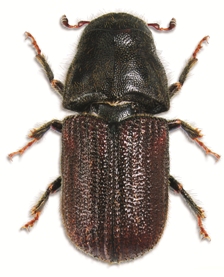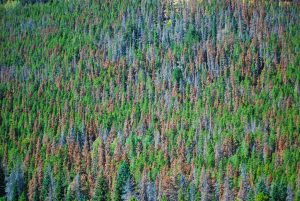 The forest cover in North America apparently turns red. But isn’t it supposed to be green?
The forest cover in North America apparently turns red. But isn’t it supposed to be green?
The trees can’t help themselves at times. These are the times when the mountain pine beetles attack these trees and disturb their appearance.
The mountain beetle menace is not limited to the appearance of the trees. They literally kill the trees once they attack the trees.
Mountain Pine Beetles just don’t attack trees from the mountains. They’ve made their way to cities and towns, sometimes even catching a ride into town on firewood.
The mountain pine beetle has a one-year life cycle in most of its range but may take more or less time to complete its development, depending on local temperatures. Adult beetles usually disperse in July or August, depending on the region, to colonize new host trees.
 In western North America, the current outbreak of the mountain pine beetle and its microbial associates has destroyed wide areas of lodgepole pine forest, including more than 16 million of the 55 million hectares of forest in British Columbia.
In western North America, the current outbreak of the mountain pine beetle and its microbial associates has destroyed wide areas of lodgepole pine forest, including more than 16 million of the 55 million hectares of forest in British Columbia.
According to an annual assessment by the United State’s forest service, 264,000 acres of trees in Colorado were infested by the mountain pine beetle at the beginning of 2013. This was much smaller than the 1.15 million acres that were affected in 2008 because the beetle has already killed off most of the vulnerable trees.
Beetle killed trees impede elk and elk hunters
November 25, 2014, By Kelsey Dayton
For 17 years Jeff Corson has owned property on the Medicine Bow National Forest near Baggs and Encampment. Walking through the woods, both hiking in the summer and stalking elk in the fall, he’s noticed more and more deadfall.
“It’s a lot harder for me to get around,” he said. “And there’s still a lot left to fall.”
As of 2013, more than half of Medicine Bow’s 1.3 million acres were impacted by the mountain pine beetle. The epidemic has receded, but in the aftermath, forests are left with thousands of acres of trees that are dead and falling. Those same trees that make it difficult for Corson to get around could also present challenges for elk on the move.
Small pine beetle destroying large Ocean County Park
By Nora Muchanic, Tuesday, June 14, 2016
LAKEWOOD, N.J. (WPVI) – Some of the trees in Lakewood, New Jersey have stood for over 100 years, planted by oil tycoon and conservationist John D. Rockefeller at what was once his country estate.
It’s now Ocean County’s flagship park where over 1,000 trees have recently been cut down due to an infestation of the relentless and aggressive southern pine beetle.
“If we don’t get a handle on it, these little pine beetles will destroy the trees. They go from one to another,” Ocean County Parks Superintendent Mary Jane Bavais said.
Rich Reenstra, the Ocean County forester, says the southern pine beetle is the size of a grain of rice. It bores into a tree’s bark to feed and breed, injecting a fungus that looks like a dark line.
“That fungus actually girdles the tree and kills below the bark the tree’s ability to transport water,” Reenstra said.
The beetles basically starve the tree, killing its leaves and causing bare branches. The trees try to fight back pushing the invaders out in a sticky ball of sap, but it doesn’t always work.
To stop the nuisance caused by these bugs there is a need for an effective solution and C Tech Corporation has one!
The unique product Combirepel™manufactured by C Tech Corporation is an anti-insect aversive which repels insects.
Combirepel™ is available in the form of the masterbatch, which can be incorporated with the polymeric applications like tree guards, pipes, agricultural films, wires, and cables, etc. to keep insects at bay.
The product available in the form of liquid concentrate can be mixed in paints in a predetermined ratio and lacquer which can be applied topically to the applications.
The product available in the form of lacquer can be used as a topical application and can be applied to the tree trunks to keep the pests at a distance from the trees.
To keep the insects at the bay Combirepel™ lacquer can be sprayed or coated on the tree trunks.
The product is also effective against a multitude of other insects and pests like beetles, mayflies, thrips, aphids, etc. The repelling mechanism of the product would ward off the boxelder bugs and other insects that could cause damage. Thus, by using Combirepel™ would effectively ensure that the area around us remain safe and protected from the pests for a long period of time.
Why resort to killing when we can just repel them!?
Our product works on the mechanism of repellency. It temporarily inhibits the mating cycle of the insects. The product impairs the ability of the insects to reproduce, that is the insects will not lay eggs or the laid eggs will be infertile. The product causes feeding disruption in an insect by triggering an unpleasant reaction within the insect which might try to feed on the application. The product temporarily blocks the reproduction system of the insects by hindering the release of the vital hormones for growth.
Contact us at technical.marketing@ctechcorporation.com to keep the pests away.
Also, visit our websites:
http://www.ctechcorporation.com/
http://www.rodrepel.com/
http://www.termirepel.com/
http://www.combirepel.com/
Follow our Facebook pages at:
1] https://www.facebook.com/Combirepel-411710912249274/
2] https://www.facebook.com/Termirepel-104225413091251/
3] https://www.facebook.com/Rodrepel-120734974768048/
Follow us on our Twitter pages at:
1] https://twitter.com/rodrepel
2] https://twitter.com/termirepel
3] https://twitter.com/combirepel
